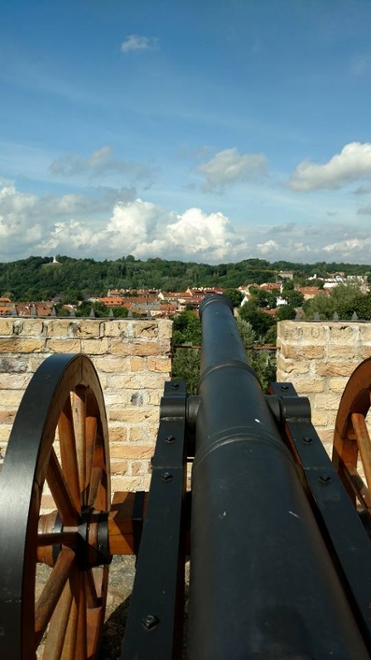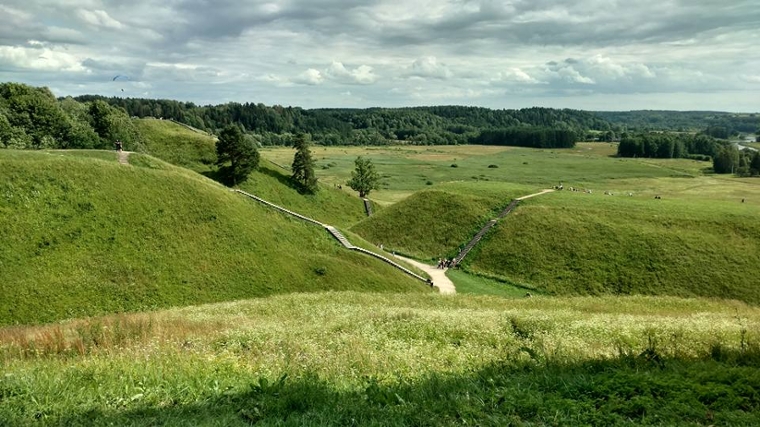Week 6: More Lithuanian History and Working for a Nonprofit
This past Wednesday, July 6, was Lithuanian Statehood Day, which celebrates the coronation in 1253 of Mindaugas, the first and only king of Lithuania. I spent my day off in Birštonas, a resort and spa town not far from Vilnius. Birštonas, is a very health conscious town, and is surrounded by pine forests and Lithuania’s largest river, the Nemunas. People travel there to engage in various forms of balneotherapy (such as wading through water of different temperatures or walking barefoot along different surfaces), drink water straight from one of Birštonas’ many mineral pools (very healthy I’m sure, but I can’t say I enjoy the taste), or simply feel the town’s crisp, clear air. For Statehood Day, Birštonas had both a strongman competition and the women’s world hot air balloon competition.
Upon returning to Vilnius, I attended one of the many concerts that were being held in the center of the city, which was followed by a gathering in Kudirkos Square, presided over by well-known Lithuanian tv personalities. There was much singing of patriotic songs and a large screen that broadcast to similar gatherings across the country. It was easy to get swept up in the patriotic fervor, especially as a child ran by with the country’s yellow, green, and red flag draped over his back like a cape claiming to be Captain Lithuania. While there were no fireworks that night, there was a 3-D movie projected on the side of the Palace of the Grand Dukes detailing the history of Lithuania from Mindaugas’ coronation to today in suitably dramatic fashion (at one point the double headed eagle of Russia rips Lithuania off of the map, revealing bloodied flesh beneath, but the presentation ended with a chorus of children singing, so at least it went out on a high note).
Feeling the patriotic fever, I delved further into Lithuanian history this week, including a trip to some of Vilnius’ old defensive fortifications. Further, many of the statues in Vilnius have QR Codes on the side that when scanned will provide information on the statue in the first person, some with a dose of humor. I had a fun time searching the city for statues, and I met some interesting people from Lithuania’s past. I met Grand Duke Gediminas, who founded Vilnius in the early Fourteenth Century after dreaming of a howling wolf while on a hunting trip - the howling signaled that Vilnius’ fame would be sounded around the world. I met Žemaitė, an influential author of Nineteenth Century peasant life, and the only woman to appear on Lithuanian currency. I met Adomas Mickevičius, who is the national poet of both Lithuania and Poland. To this day, Lithuanians and Poles argue over the right to claim him as their own, which is just one of many historical feuds between the two nations that once formed a joint commonwealth. Poles and Lithuanians still argue about who should get credit for the victory over the Teutonic Knights in the Battle of Grunwald, a battle that occurred more than 600 years ago. Still, their union was very fruitful for both countries. The Grand Duchy of Lithuania was once the largest state in Europe, and became so completely through marriage, not conquest, prompting the director of VIL IAS to proclaim that the national slogan should be "Lithuania is for lovers."

My survey of history brought me to Kernavė, where people have lived since at least 9,000 BC. Kernavė featured the most beautiful countryside I have yet seen, with great green mounds where castles once stood rising from the earth and the Neris River flowing serenely in the background. The view from atop one of those hills (or piliakalniai, literally “castle-mountain”) is a truly breathtaking sight. Near the mounds was a small village filled with reenactors baking bread, making soap, or demonstrating their skill at arms. Lithuania’s version of Colonial Williamsburg, if you will. What will stick with me is the music, played masterfully on a variety of archaic instruments that should make their way into more modern pop songs.

To switch course for a minute, my work this week was heavily focused on the practical side of working for a nonprofit: funding. The European Union provides a great deal of funding for a wide variety of projects, and all information about who is being funded and for what is available online. My job this week was to comb through thousands of past projects to A) identify organizations that have been funded in the past that could act as potential partners, preferably from Eastern Europe but not the Baltics; and B) identify practices in Western Europe that can be mapped onto an Eastern European country like Lithuania. Both of these goals are tied into what the EU wants to see before it funds a project. Past success is important, of course, hence the goal of partnering with organizations that have had success. While not a stated objective of EU grants, past experience shows that projects that map the values of Western Europe onto Eastern Europe are going to be favored, as are projects that spread influence to multiple regions, hence the desirability of finding partners outside of the Baltics. So much time for a nonprofit is spent trying to secure funding, and I found myself in the weeds on that this week.